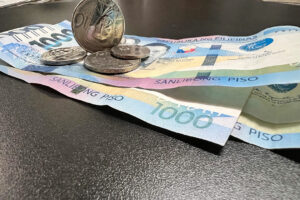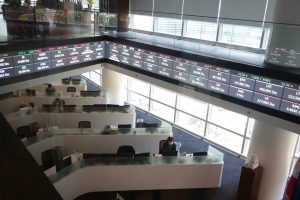Peso seen broadly steady before data releases

THE PESO may be broadly steady against the greenback this week ahead of the release of key economic data and expectations of a delayed start to the Bangko Sentral ng Pilipinas’ (BSP) easing cycle.
The local unit closed at P56.53 per dollar on Friday, depreciating by three centavos from its P56.50 finish on Thursday, Bankers Association of the Philippines data showed. Week on week, the peso likewise weakened from its P56.50 close on April 5.
The peso depreciated after hawkish signals from US Federal Reserve officials after higher-than-expected US consumer price index (CPI) data, Rizal Commercial Banking Corp. Chief Economist Michael L. Ricafort said in a Viber message.
The ranks of Federal Reserve officials saying there is no rush to cut interest rates continue to grow, with still-too-hot-for-comfort US inflation a rising concern at home and casting a shadow over expectations for policy easing abroad as well, Reuters reported.
“There’s no clear need to adjust monetary policy in the very near term,” New York Fed President John Williams told reporters on Thursday, a day after disappointingly strong consumer price inflation prompted traders and some analysts to predict a later start to Fed rate cuts, and likely fewer of them.
“Recent data suggest it may take more time than I had previously thought to gain greater confidence in inflation’s downward trajectory, before beginning to ease policy,” Boston Fed President Susan Collins said at a different venue in New York, adding that a strong labor market “also reduces the urgency to ease.”
The two were among several US central bankers voicing caution in recent days about moving too quickly to cut interest rates when inflation appears to be — at best — on what Fed Chair Jerome H. Powell has called a “bumpy” path back to the central bank’s 2% annual target.
Inflation is proving to be a stickier problem than US central bank officials had anticipated it would be just a couple of months ago, while other measures of the economy show little signs of slowing down. That combination has pushed the anticipated start of an easing cycle further down the road.
Richmond Fed President Thomas Barkin, who had already noted his concerns about the breadth of inflation being hard to “reconcile” with a near-term shift to rate cuts, said Thursday the latest numbers “did not increase my confidence” that price pressures were easing on a broader basis throughout the economy.
US consumer price index (CPI) data came in stronger than expected in March, prompting a broad resetting of expectations for when the Fed will be able to cut rates this year. Financial markets are now pricing in a July or September start to Fed rate cuts, versus an earlier view of June.
The CPI rose 0.4% last month after advancing by the same margin in February, the Labor department’s Bureau of Labor Statistics said.
In the 12 months through March, the CPI increased 3.5%, the most since September. The CPI was also boosted by last year’s low reading dropping out of the calculation. It rose 3.2% in February. Economists polled by Reuters had forecast the CPI gaining 0.3% on the month and advancing 3.4% year on year.
For this week, Mr. Ricafort said that the main driver for foreign exchange trading will be the remittances data scheduled for release on Monday (April 15) and the balance of payments report on Friday (April 19).
Markets also expect the BSP to extend its hawkish pause, which would help support and stabilize the exchange rate, Mr. Ricafort added.
The Monetary Board’s next policy meeting is on May 16.
BSP Governor Eli M. Remolona, Jr. last week said that the central bank is leaning towards being “somewhat more hawkish” as upside risks to inflation have worsened.
The BSP could cut rates as late as the first quarter of 2025 if these risks are not contained, Mr. Remolona added.
The Monetary Board kept its benchmark rate steady at a near 17-year high 6.5% for a fourth straight meeting at its policy review last week.
Security Bank Corp. Chief Economist Robert Dan J. Roces and Mr. Ricafort expect the peso to move between P56.30 and P56.70 per dollar this week. — L.M.J.C. Jocson with Reuters




